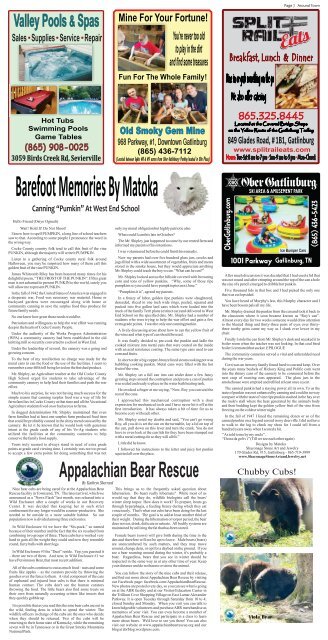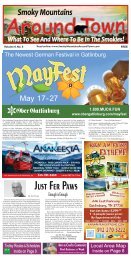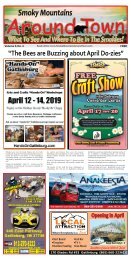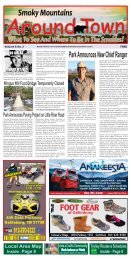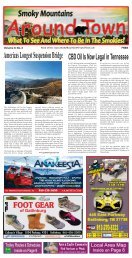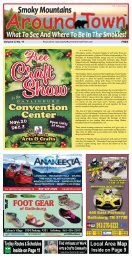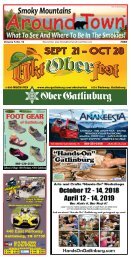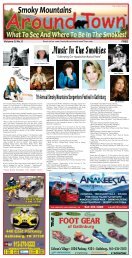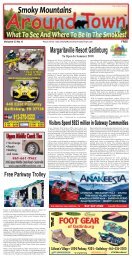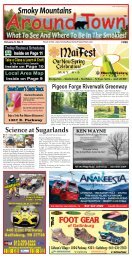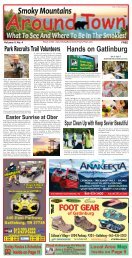Smoky Mountains Around Town / December 2018
What To See And Where To Be In The Smokies!
What To See And Where To Be In The Smokies!
You also want an ePaper? Increase the reach of your titles
YUMPU automatically turns print PDFs into web optimized ePapers that Google loves.
Valley Pools & Spas<br />
Sales • Supplies • Service • Repair<br />
Mine For Your Fortune!<br />
You’re never too old<br />
to play in the dirt<br />
and find some treasures<br />
Fun For The Whole Family !<br />
Page 7 <strong>Around</strong> <strong>Town</strong><br />
Hot Tubs<br />
Swimming Pools<br />
Game Tables<br />
(865) 908-0025<br />
3059 Birds Creek Rd, Sevierville<br />
Old <strong>Smoky</strong> Gem Mine<br />
968 Parkway, #1, Downtown Gatlinburg<br />
(865) 436-7112<br />
(Located between lights #8 & #9 across from Ober Gatlinburg - Parking located in Elks Plaza)<br />
849 Glades Road, # 1B1, Gatlinburg<br />
www.splitraileats.com<br />
Hello Friend (Osiyo Oginali)<br />
Wait! Hold It! Do Not Shoot!<br />
I know how to spell PUMPKIN, a long line of school teachers<br />
saw to that. According to some people I pronounce the word in<br />
the wrong way.<br />
Cocke County country folk tend to call this fruit of the vine<br />
PUNKIN, although the majority will write it PUMPKIN.<br />
Listen to a gathering of Cocke county rural folk around<br />
Halloween, you may be surprised how many of them call this<br />
golden fruit of the vine PUNKIN.<br />
James Whitcomb Riley has been honored many times for his<br />
delightful poem, “THE FROST OF THE PUNKIN”. If this great<br />
man is not ashamed to present PUNKIN to the world, surely you<br />
will allow me to present PUNKIN.<br />
In the fall of 1942 the United States of America was engaged in<br />
a desperate war, Food was necessary war material. Home or<br />
backyard gardens were encouraged along with home or<br />
community canning to save the surplus food thus produce for<br />
future family needs.<br />
No one knew how great those needs would be.<br />
Patriotism and willingness to help the war effort was running<br />
deep in the hearts of Cocke County People.<br />
Under the authority of the Works Progress Administration<br />
(WPA) a community cannery had been established in the old<br />
knitting mill so recently converted to a school in West End.<br />
Under the leadership of several, the cannery was a going and<br />
growing concern.<br />
To the best of my recollection no charge was made for the<br />
metal cans to can the food or the use of the facilities. I seem to<br />
remember a one-fifth toll being levied on the finished product.<br />
Mr. Shipley, an Agriculture teacher at the Old Cocke County<br />
High School urged his students to take advantage of the<br />
community cannery to help feed their families and push the war<br />
effort.<br />
Much to his surprise, he was not having much success for the<br />
simple reason that canning surplus food was a way of life for<br />
farm families in Cocke County at that time and all the Vocational<br />
Agriculture students lived on or had access to farms.<br />
In dogged determination Mr. Shipley maintained that even<br />
farm families had at least one surplus farm produced food item<br />
that could be profitably canned in the shiny metal can used by the<br />
cannery. He let it be known that he would look with generous<br />
intent at the grade cards of any of his Vo-Ag students who<br />
utilized the facilities at the community canneries to help<br />
conserve the family food supply.<br />
Yours truly seemed to always stand in need of extra grade<br />
points at grade card viewing time. I certainly was not too proud<br />
to accept a few extra points for doing something that was not<br />
only my moral obligation but highly patriotic also.<br />
What could I can this late in October?<br />
The Mr. Shipley just happened to come by our rented farm and<br />
informed my parents of his intentions.<br />
I was volunteered before he could finish his remarks.<br />
Now my parents had over five hundred glass jars, crocks and<br />
jugs filled with a wide assortment of vegetables, fruits and meats<br />
stored in the smoke house, but they would appreciate anything<br />
Mr. Shipley could teach the boy to can. “What can he can?”<br />
Mr. Shipley looked across the hillside covered with browning<br />
corn and tons of yellow punkins. “Why, some of those ripe<br />
pumpkins so you could have pumpkin pies next June.”<br />
“Pumpkins it is”, agreed my parents.<br />
In a frenzy of labor, golden ripe punkins were slaughtered,<br />
deseeded, sliced in one inch wide rings, peeled, squared and<br />
packed into five gallon lard cans which were loaded into the<br />
truck of the family Terri plane (extinct car) and delivered to West<br />
End School on the specified date. Mr. Shipley had a number of<br />
students who were trying to help the war effort and gain a few<br />
extra grade points. I was the only one canning punkin.<br />
A lively discussing arose about how to can the yellow fruit of<br />
the wine and what type of can should be used.<br />
It was finally decided to pre-cook the punkin and ladle the<br />
cooked mixture into metal cans that were coated on the inside<br />
with an acid resistance coating. The same type cans used to can<br />
corn and fruits.<br />
In short order a big copper-bronze lined steam cooking pot was<br />
bubbling cooking punkin. Metal cans were filled with the hot<br />
fruit of the vine.<br />
Mr. Shipley set a full can into can sealer done a few fancy<br />
gyrating steps around the contraption and presto a can of punkin<br />
was sealed and ready to place in the water bath heating tank.<br />
He crooked a finger at me saying, “Now, Roy you can seal the<br />
rest of the cans.<br />
I approached this mechanical contraption with a dour<br />
expression for mechanical tools and I have never hit it off at the<br />
first introduction. It has always taken a bit of time for us to<br />
become cozy with each other.<br />
Mr. Shipley noted my doubts and said, “You can't go wrong<br />
Roy, all you do is set the can on the turntable, lay a lid on top of<br />
the can, pull down on this lever and turn the crank. You do not<br />
have to even look at the can lids for they have been stamped out<br />
with a metal cutting die so they will all fit.”<br />
Little did he know.<br />
I followed his instructions to the letter and juicy hot punkin<br />
squirted all over the place.<br />
Ice Bumper Cars<br />
After much discussion it was decided that I had used a lid that<br />
was not round and after crimping around the top of the can a hole<br />
the size of a pencil emerged to dribble hot punkin.<br />
Five thousand lids in that box and I had picked the only one<br />
that was cut lopsided.<br />
You have heard of Murphy's law, this Murphy character and I<br />
have been bosom pals all my life.<br />
Mr. Shipley drained the punkin from the can and took it back to<br />
the classroom where it soon became known as “Roy's can”.<br />
Almost every day for two weeks someone would draw attention<br />
to the blasted thing and thirty-three pairs of eyes over thirtythree<br />
toothy grins came my way as I slunk ever lower in my<br />
chair.<br />
Finally I stole the can from Mr. Shipley's desk and sneaked it to<br />
boiler room when the teacher was not looking. In that coal fired<br />
boiler I cremated that sucker. EPILOGUE<br />
The community canneries served a vital and unheralded need<br />
during the war years.<br />
Corn was an item my family found hard to can and keep. Over<br />
the years many bushels of Hickory King and Polific corn went<br />
into the shinny cans of the cannery to be consumed before the<br />
next crop of roasting ears appeared. The glass jars in the<br />
smokehouse were emptied and refilled at least once a year.<br />
The canned punkin had a staying power all its own. To us the<br />
taste of punkin was not enhanced by canning and could in no way<br />
compare with the taste of vine ripe punkin stashed in the hay over<br />
the mule's stall where the heat generated by the animal's body<br />
and their bedding kept the golden yellow fruit of the vine from<br />
freezing on the coldest winter night.<br />
In the fall of 1947 I lined the remaining dozen or so of the<br />
canned punkin on a log and zeroed in my deer rifle. I did not have<br />
to walk to the log to check my shots for I could tell from a<br />
hundred years away when I scored a hit.<br />
“As told to me by my uncle”.<br />
“Do na da go hv i” (Till we see each other again)<br />
Designs by Matoka<br />
Shaconage Stone Art and Jewelry<br />
170 Glades Rd, #15, Gatlinburg - 865-719-3999<br />
www.ShaconageStoneArtandJewelry.net<br />
Appalachian Bear Rescue<br />
By Kathryn Sherrard<br />
Chubby Cubs!<br />
Nine bear cubs are being cared for at the Appalachian Bear<br />
Rescue facility in <strong>Town</strong>send, TN. The latest arrival, which we<br />
announced as a “News Flash” last month, was released into a<br />
Wild Enclosure after a couple of weeks in our Recovery<br />
Center. It was decided that keeping her in such strict<br />
confinement for any longer would be counter-productive. She<br />
needed to be outside in a more suitable habitat. So our<br />
population now is divided among three enclosures.<br />
In Wild Enclosure #4 we have the “Six-pack,” so named<br />
because of their number and the fact that the six resulted from<br />
combining two groups of three. These cubs have worked very<br />
hard to gain all the weight they could and now they resemble<br />
round, furry balls with short legs.<br />
In Wild Enclosure #3 the “Duet” reside. Yep, you guessed it<br />
– there are two of them. And now, in Wild Enclosure #1 we<br />
have Persimmon Bear, that most recent addition.<br />
All of the cubs continue to eat as much food – nuts and some<br />
fruits like apples – as the curators provide by throwing the<br />
goodies over the fence to them. A vital component of the care<br />
of orphaned and injured bear cubs is that there is minimal<br />
human contact. The cubs don't see the human curators<br />
throwing the food. The little bears also find some treats on<br />
their own from naturally occurring critters like insects that<br />
they quickly gobble up.<br />
It is possible that as you read this the nine bear cubs are out in<br />
the wild, finding dens in which to spend the winter. The<br />
wildlife officers in charge of the cubs are the ones who decide<br />
when they should be released. Two of the cubs will be<br />
returning to their home state of Kentucky, while the remaining<br />
seven will be in Tennessee or in the Great <strong>Smoky</strong> <strong>Mountains</strong><br />
National Park.<br />
This brings us to the frequently asked question about<br />
hibernation. Do bears really hibernate? While most of us<br />
would say that they do, wildlife biologists call the bears'<br />
winter sleep torpor. How does it work? To prepare, bears go<br />
through hyperphagia, a feeding frenzy during which they eat<br />
voraciously. That's what our cubs have been doing for the last<br />
couple of months. The goal is to add at least another third of<br />
their weight. During the hibernation or torpor period, the bear<br />
does not eat, drink, defecate or urinate. All bodily systems are<br />
maintained by utilizing the fat that has been stored.<br />
Female bears (sows) will give birth during the time in the<br />
den and therefore will not be apt to leave. Male bears (boars)<br />
are unencumbered by such matters, and they may move<br />
around, change dens, or opt for a daybed on the ground. If you<br />
see a bear roaming around during the winter, it's probably a<br />
boar. Regardless, bears that you see in winter should be<br />
respected in the same way as at any other time of year. Keep<br />
your distance and do not harass or stress the animal.<br />
You can follow the story of the nine cubs and their release,<br />
and find out more about Appalachian Bear Rescue by visiting<br />
our Facebook page: facebook.com/AppalachianBearRescue.<br />
New photos are posted every day, so you can see what is going<br />
on at the ABR facility and at our Visitor/Education Center in<br />
the Trillium Cove Shopping Village on East Lamar Alexander<br />
Parkway. It is open Tuesday through Saturday from 10 to 4;<br />
closed Sunday and Monday. When you visit you can talk to<br />
knowledgeable volunteers and purchase ABR merchandise as<br />
mementos of your visit. You can even become a member of<br />
Appalachian Bear Rescue and participate in a class to learn<br />
more about bears. We'd love to see you there! You can also<br />
visit our website at www.appalachianbearrescue.org and our<br />
blog at abrblog.wordpress.com.


